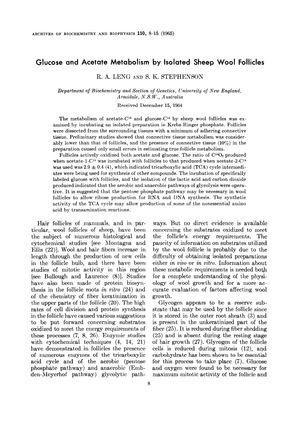Glucose and Acetate Metabolism by Isolated Sheep Wool Follicles
April 1965
in “
Archives of biochemistry and biophysics
”
sheep wool follicles acetate metabolism glucose metabolism aerobic glycolysis anaerobic glycolysis tricarboxylic acid cycle TCA cycle Embden-Meyerhof pathway pentose phosphate pathway lactic acid ribose DNA synthesis RNA synthesis wool follicles acetate glucose aerobic metabolism anaerobic metabolism Krebs cycle glycolysis PPP lactic acid ribose DNA RNA

TLDR Sheep wool follicles can metabolize both glucose and acetate using different pathways important for wool growth.
In 1965, R.A. Leng and S.K. Stephenson conducted a study on isolated sheep wool follicles, demonstrating that these follicles metabolize both acetate-C¹⁴ and glucose-C¹⁴. The follicles utilized aerobic and anaerobic glycolysis pathways, with evidence of the tricarboxylic acid (TCA) cycle's involvement in the metabolism of acetate, as indicated by the ratio of C¹⁴O₂ produced from acetate-1-C¹⁴ to acetate-2-C¹⁴ (2.9 ± 0.4). The study also found that glucose metabolism could proceed via the Embden-Meyerhof pathway or the pentose phosphate pathway, with the latter suggested by the specific radioactivity of lactic acid produced and the need for ribose in DNA and RNA synthesis. The presence of connective tissue did not significantly affect the results, as its metabolism was much lower than that of the follicles. This research provided insights into the metabolic processes within wool follicles, which are important for wool growth and could impact wool production. The study was supported by the Wool Research Committee and the University of New England.